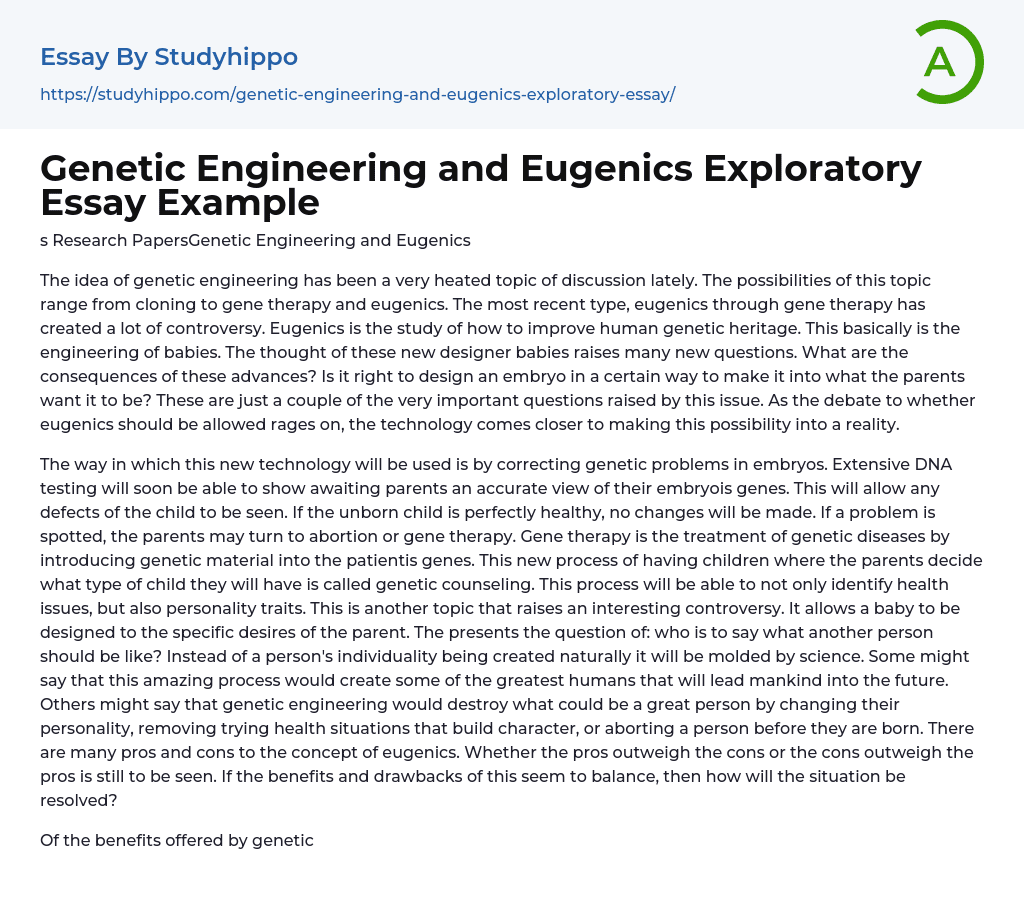The topic of genetic engineering has sparked heated debates, exploring various possibilities such as cloning, gene therapy, and eugenics. Among these possibilities, the controversial concept of eugenics through gene therapy involves enhancing the human genetic heritage to create babies that meet specific preferences. This raises important questions about ethics and implications. While the debate on whether eugenics should be allowed continues, advancements in technology are rapidly turning this potential into a reality.
With new technology aiming to correct genetic abnormalities in embryos through DNA testing, expectant parents can gain accurate knowledge about their embryo's genes. If any defects are identified, options like abortion or gene therapy may be considered for addressing the problem. Gene therapy involves introducing genetic material into a patient's genes to treat genetic diseases.
Another aspect that stirs controversy is genetic counseling, which allows parents
...not only to detect health issues but also determine their child's traits including personality traits. This raises concerns regarding who holds the authority to determine another person's characteristics since science would shape individuality instead of allowing natural development.
The text discusses both the advantages and disadvantages of eugenics. Some argue that it could produce exceptional individuals for a better future.Critics argue that genetic engineering has the potential to eliminate greatness, change personalities, and even result in terminated pregnancies. The concept of eugenics is a delicate balance between benefits and drawbacks. One advantage is germ-line therapy's ability to treat cancer and genetic disorders by modifying genes and passing on these modified traits to future generations. This passage explores the impact of genetic engineering on creating a child with genes that can counteract genetic illnesses. The procedure involves injecting an artificial human
chromosome into a fertilized egg, which then grows alongside the developing embryo. This technology presents opportunities for longer and healthier lives by curing diseases and altering behavioral and physical traits. It also raises the possibility of designing a "perfect child" based on parental preferences, potentially advancing human evolution and improving overall well-being. However, despite these exciting advancements, there are concerns about the potential consequences of genetically engineered humans similar to the negative associations with Nazi eugenics ideals. Although less extreme, this new form of eugenics could perpetuate inequalities and discrimination between those who have undergone genetic engineering and those who have not. It emphasizes that while certain genetic diseases may be cured through this process, there is a chance for new ones to emerge, resulting in an ongoing battle against them.Moreover, there are concerns about the role of parenting as Boukhari and Otchet argue that parents should not force their children to conform to their desires. This poses a risk for children. On the other hand, parents also face challenges related to gene therapy. If this therapy becomes publicly available, parents may feel pressured to do everything possible to help their baby. However, if they choose not to use the therapy due to religious or personal beliefs and an issue arises for the child, they will feel extreme guilt and self-blame for something beyond their control.
Even if treatment is given during the embryo stage, its success remains uncertain with a chance of another illness occurring. These uncertainties can overwhelm parents with guilt. As we become aware of the drawbacks of eugenics, many question whether this step will do more harm than good for humanity. The
ongoing debate surrounding this process discussed in this text is bringing us closer to it becoming a reality.
Ongoing animal experiments aim to show that there are no negative outcomes associated with this process. The future of gene therapy is expected within approximately three years. Although it was initially intended for the betterment of humanity, there is potential for it to be taken too far. Sharon Begley raises a thought-provoking question: "We know where to start;The more challenging question is whether we are aware of the point at which to cease. This text amalgamates information from three distinct sources. The initial source is an article named "Designer Babies" sourced from Newsweek, released on November 9, 1998 (page 61). The second source is an article titled "Uncharted Terrain on Tomorrow's Genetic Map" composed by Sophie Boukhari and Amy Otchet, featured in UNESCO Courier in September 1999 (page 18). Lastly, the third source originates from a book edited by William Dudley entitled "Genetic Engineering: Opposing Viewpoints," published by Greenhaven Press in San Diego in 1990.
- Dna essays
- Gene essays
- Administration essays
- Architect essays
- Discipline essays
- Doctor essays
- Engineer essays
- Farmer essays
- Hunter essays
- Labor essays
- Model essays
- Nurse essays
- Pilot essays
- Police Officer essays
- Professionalism essays
- Social Work essays
- Stakeholders essays
- Teamwork essays
- Agriculture essays
- Albert einstein essays
- Animals essays
- Archaeology essays
- Bear essays
- Biology essays
- Birds essays
- Butterfly essays
- Cat essays
- Charles Darwin essays
- Chemistry essays
- Dinosaur essays
- Discovery essays
- Dolphin essays
- Elephant essays
- Eli Whitney essays
- Environmental Science essays
- Evolution essays
- Fish essays
- Genetics essays
- Horse essays
- Human Evolution essays
- Isaac Newton essays
- Journal essays
- Linguistics essays
- Lion essays
- Logic essays
- Mars essays
- Methodology essays
- Mineralogy essays
- Monkey essays
- Moon essays




